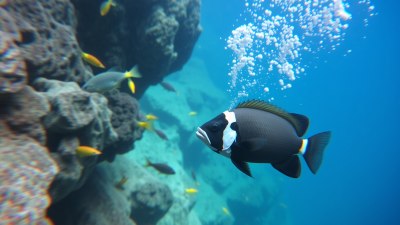Learning to Identify Local Fish and Marine Life on Dives
Enhance your diving experience by learning to identify local fish and marine life.

Image created with Flux Schnell
Diving offers an incredible opportunity to explore the underwater world, revealing diverse ecosystems teeming with life. However, to truly appreciate the marine environment, it is essential to learn how to identify local fish and marine life. Not only does this enhance your enjoyment of diving, but it also fosters environmental stewardship and awareness of the ecosystems you explore. This guide aims to provide the foundational knowledge and tools necessary for divers to identify local fish and marine life effectively.
The Importance of Identification
Understanding the species inhabiting a dive site can provide insight into the health of the ecosystem. Each fish and marine organism plays a specific role in its environment, from predators to prey, and includes symbiotic relationships that maintain the balance of marine life. By recognizing these species, divers can observe behaviors, understand their ecological roles, and contribute to conservation efforts.
Basic Fish Anatomy
Before diving into identification techniques, understanding basic fish anatomy can be beneficial. Fish generally have three parts: the head, the body, and the tail. Key features to observe include:
- Fins: Fish typically have dorsal fins, pectoral fins, pelvic fins, anal fins, and a caudal fin.
- Scales: Vary in shape, size, and coverage on the body. They can help with identification.
- Coloration and Patterns: Colors and patterns can indicate species, age, or health status.
- Mouth Shape: Different shapes indicate different feeding habits.
When learning about marine life, paying attention to these features can significantly aid in identification.
Tools for Identification
Several resources are available for divers to help with identification, including:
- Field Guides: Books tailored to specific regions offer valuable insights and images of local marine life.
- Mobile Apps: Numerous apps provide databases of fish and marine species, complete with pictures and identification tips, suitable for use underwater.
- Online Resources: Websites and forums dedicated to diving often contain detailed information and photos submitted by fellow divers.
- Local Dive Shops and Organizations: Many dive shops offer identification courses or workshops, connecting divers with local marine biologists.
Utilizing these tools can enhance your dive experience while contributing to your knowledge of marine ecology.
Identifying Fish Species
When attempting to identify fish species, it can be helpful to consider several broad categories:
- Reef Fish: Common in tropical waters, examples include clownfish, damselfish, and parrotfish. They often exhibit bright colors and unique patterns.
- Pelagic Fish:These fish inhabit open waters and include species such as tuna, mackerel, and barracuda. They are generally larger and may be more challenging to identify due to their fast swimming.
- Bottom-dwelling Fish: Species like flounder and sole utilize camouflage to blend in with the ocean floor. Observation of their habitat will often reveal their presence.
- Shark and Ray Species: Identify species like reef sharks, hammerhead sharks, and manta rays by their distinctive body shapes and behaviors.
Each species has unique characteristics; taking the time to observe these features will improve your identification skills.
Identifying Invertebrates
In addition to fishes, divers encounter numerous invertebrates, which may include:
- Crustaceans: Observe crabs, lobsters, and shrimp, often hiding in crevices. Identifying them may involve looking at their body shapes and claw sizes.
- Mollusks: Commonly seen species include octopuses, squids, and various types of snails. Their textures and colors can provide clues for identification.
- Corals: Coral species provide structure for marine life. They come in various shapes and colors, like branching, table, or massive corals.
Familiarizing yourself with common invertebrates enhances your overall understanding of the marine environment.
Observation Techniques
To effectively identify marine life while diving, adopt the following techniques:
- Slow Movement: Many fish species can be shy; moving slowly and quietly increases the chances of closer encounters.
- Stay Aware of Your Surroundings: Keep your head up and scan the environment; fish can appear while you are focused on something else.
- Buddy System: Diving with a partner allows you to share observations and helps with identification. Each diver may notice different species.
- Take Notes or Photos: After a dive, jotting down what you observed can assist in later identification. Photos taken underwater also aid identification.
Implementing these techniques will heighten your awareness of marine life and improve identification skills.
Marine Conservation Awareness
As divers learn to identify local fish and marine life, it is essential to understand the significance of marine conservation. Many fish populations face threats from overfishing, habitat destruction, and pollution. By identifying species, divers can contribute to local marine conservation efforts by reporting observations of fish populations to researchers or engaging in conservation programs.
Participation in initiatives like reef cleanups and conservation awareness campaigns can make a difference for marine ecosystems. Understanding the role of various species and advocating for their protection fosters a sense of responsibility among divers.
Joining Local Dive Groups
Engaging with local dive groups can enhance your identification skills and bring you closer to the local diving community. Participating in group dives, workshops, and informational sessions can further improve your knowledge by connecting you with experienced divers and marine enthusiasts.
Many dive communities promote awareness of local marine life and conservation causes, offering educational opportunities and outings focused on specific species. By surrounding yourself with knowledgeable and enthusiastic divers, you can hone your skills, make lasting friendships, and contribute positively to your local ecosystem.
Identifying local fish and marine life is a rewarding aspect of diving that enhances your underwater experiences. Through building your knowledge base, observing with patience, and utilizing available resources, you can become proficient in recognizing the diverse species you encounter. Ultimately, this skill contributes to a greater understanding of marine ecosystems, promoting awareness and advocacy for the protection of our oceans. Embrace the challenge of learning, engage with your dive community, and let each dive reveal the wonder of the underwater world.











